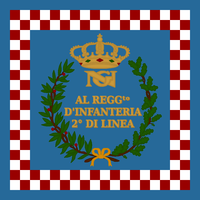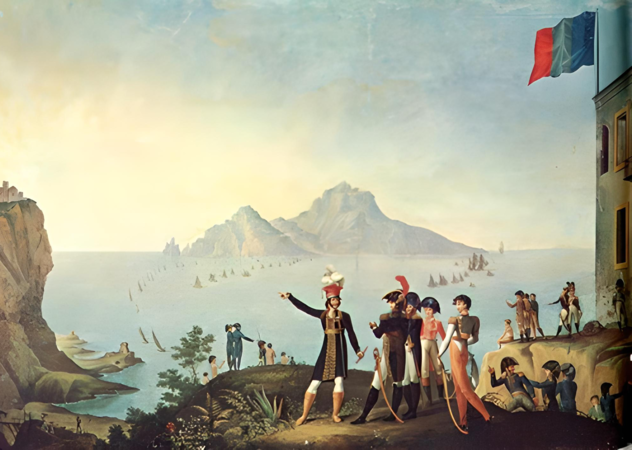Main Page: Difference between revisions
No edit summary |
No edit summary Tag: Reverted |
||
| Line 90: | Line 90: | ||
| style="color:#000; padding:2px 5px 5px; font-size:120%" | | | style="color:#000; padding:2px 5px 5px; font-size:120%" | | ||
<gallery mode="packed" class="center" widths="350" heights="300"> | <gallery mode="packed" class="center" widths="350" heights="300"> | ||
File: | File:CaptureOfCapri.png|<big>[[File:Triskeles.png|50px]]'''[[Nation Information|Government Section]]'''</big> | ||
File:Carlo Filangieri e Murat.jpg|<big>[[File:JNMonogram.png|50px]]'''[[Army of the Kingdom of Naples|Neapolitan Army Section]]'''</big> | File:Carlo Filangieri e Murat.jpg|<big>[[File:JNMonogram.png|50px]]'''[[Army of the Kingdom of Naples|Neapolitan Army Section]]'''</big> | ||
</gallery> | </gallery> | ||
|} | |} | ||
Revision as of 14:45, 23 January 2023
 , The History of the Kingdom of Naples 1806-1815, portrayed in unparalleled detail |
Nation Information Regiments Battles and Encounters Personalities |
Line Infantry Light Infantry Sieges Treaties |
Other Projects General Site Bibliography Created and designed using MediaWiki |
| |
|
At NEAPOLITONIC.com our only and unconditional goal is to ensure the conservation and spread of information on the fascinating and largely overlooked Kingdom of Naples during the late Revolutionary and Napoleonic periods. While confined to the limitations and boundaries of technology, we aim to spread our vast index of knowledge to more than just audiences behind screens. We are dedicated to pursuing knowledge and its free spread to the various echelons of modern society. (more...) | |
| |
|
More than two hundred years ago, the Apennine peninsula became embroiled in what became the first true attempt at Italian independence in history – the Neapolitan War. The conflict pitted the combined forces of Austria, Tuscany, Modena, Sicily, and Great Britain against the lone Kingdom of Naples, which itself remained the last bastion of Bonapartist power in Italy. In a desperate bid to maintain his throne in the face of foreign aggression, the flamboyant Neapolitan king Joachim Murat launched a daring campaign that would shake Italian society to the very core and set the stage for the famed events of the Risorgimento. Yet to fully comprehend the motives and origins of the Austro-Neapolitan conflict, one must first understand the Kingdom of Naples: its history, its social and political influence, and its key figures. Founded in 1806 out of the wreckage of the Bourbon Kingdom of Naples, it was initially ruled by Napoleon Bonaparte’s older brother Joseph. His brief but effective reign would bring Napoleonic customs to Southern Italy and set the groundwork for a truly self-sufficient state. When Joseph was made King of Spain by his brother in 1808, the throne of Naples was passed to one of Napoleon’s most trusted lieutenants: Joachim Murat. Under his guidance Naples would grow to become the dominant military and political presence in Southern Italy, achieving in less than a decade what the Bourbon monarchy could not accomplish in almost half a century. As a client state, the Kingdom’s borders stretched across the entirety of Southern Italy, from the hills of Abruzzo to the clear shores of Calabria. Structured along the lines of the French government, Naples would prove to be invaluable to the Napoleonic Empire by forming its southernmost line of defence, keeping in check British forces in the region. The Kingdom would also supply a number of troops to serve in Napoleon’s campaigns, namely Spain (1808-1813), Tyrol (1809), Russia (1812) and Germany (1813). The largely raw Neapolitans would prove time and again their courage and tenacity in various engagements and would even receive the honour of escorting Napoleon himself on the retreat from Russia. The Kingdom’s faith in the Bonapartist cause would waver in 1813, culminating in December 1813 when it mobilised forces to join the Austrians in fighting the Franco-Italians in Northern Italy. This caused a rift in Neapolitan society, with many trusted and experienced administrators and officers of French birth leaving their posts in order not to serve against their homeland. This would prove an immense handicap to the Neapolitan state when it eventually descended into war with Austria in early 1815. (more...) |
| |
|
NEAPOLITONIC.com is primarily divided into separate sections that each focus on a certain branch of either the Kingdom’s Government, Army, or Navy. To navigate through the site, you can either use the main page’s links, or the site’s top bar which includes a search box and several shortcuts to accessing certain sections. Unfortunately, NEAPOLITONIC.com currently does not allow editing to users without moderator permissions. This is to maintain site security and the validity of the information presented on the site. If you wish to apply to become a moderator, contact us at infoneapolitonic@gmail.com. Please Note: This site does not support mobile devices yet. Donations will be open on Monday, January 23rd. (click on the image for a detailed breakdown of donations for 2022) | |
| |
 This week's featured picture: Colours of the 2nd Line Infantry Regiment 'Regina'. NEAPOLITONIC.com has officially launched! A huge thanks to all the developers and technicians who helped this project come to life. A special thanks to Sarah at Project Murat for writing the article on Joachim Murat - it is truly the jewel of this webpage. Our first official Article of the Week will come out on Monday 23rd. |
I'm Interested In |
|
|





